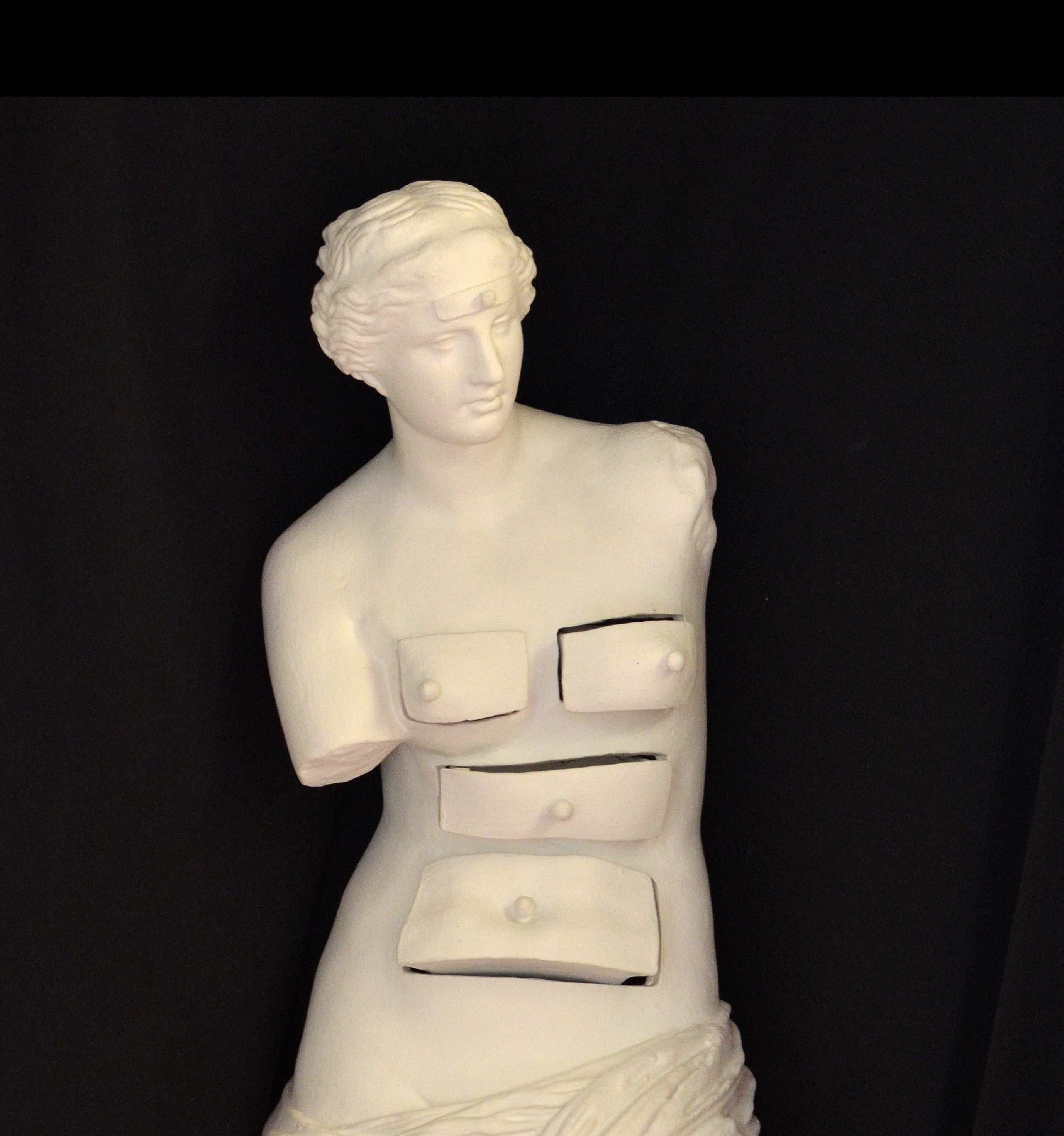In June 1939 Salvador Dalí designed a pavilion for the New York World's Fair built by the architect Ian Woodner. The building was named Dream of Venus.
The pavilion featured a spectacular facade full of protuberances, vaguely reminiscent of the Pedrera building by Antoni Gaudí. The main door was flanked by two pillars representing two female legs wearing stockings and high-heeled shoes. Through the openings of the irregular façade, visitors could see reproductions of the Saint John the Baptist by Leonardo da Vinci and The Birth of Venus by Botticelli. The outer part of the building also had crutches, cacti, hedgehogs, etc. Inside, the pavilion offered visitors an aquatic dance show in two large swimming pools, with sirens and other items also designed by Dalí, some of them taking their inspiration from the work of Bracelli. Between the painter's initial ideas and the final result of the project there arose major modifications, which led Dalí to complain about the Fair's requirements in a pamphlet entitled Declaration of the Independence of the Imagination and the Rights of Man to His Own Madness.
The New York World's Fair is a landmark in the history of design. Walter D. Teague was in charge of the overall supervision of the project, in which outstanding figures such as Raymond Loewy, Russell Wright and Norman Bel Geddes took part. The Fair, which plumped for functional architecture, is considered one of the high points of the "streamlined style". In this context, Salvador Dalí's surrealistic building is even more meaningful. The painter intervention has to be seen as a clear wish to swim against the tide: his design, full of soft and rounded forms, with its clear allusions to architecture as an intra-uterine space, primitive and archaic symbols , and classical cultural references, can only be taken as an aesthetic manifesto set against the aseptic, aerodynamic and futurist style proposed by the Fair.
In the one-man exhibition staged at the Julien Levy Gallery in New York, a few weeks before the Fair was inaugurated (21 March to 18 April), Dalí had already integrated that great Fair into his work. He did so critically by reproducing on the front cover of the catalogue the ultramodern sphere and obelisk that the Fair had adopted as symbols, but mixing them up in a sort of whirlpool or visual conglomeration with various soft structures, Leonardo-style horses, heads of Medusa and classical architectural forms.
Despite the conflicts that derived from Dalí's collaboration with the organizers of the Fair, his participation has to be rated as a highly important moment within the painter's increasing approximation to mass culture, and his need to project his ideas beyond the strict circles of artistic culture. In this sense it may not be exaggerated to state that The Dream of Venus was a first version (though with features and a context of its own) of that other enormous "inhabitable" and "visitable" artistic object that was to be the Dalí Theatre-Museum of Figueres many years later.
The exhibition "Salvador Dalí. Dream of Venus" aims at bringing together the above-mentioned aspects, which could be summed up in three sub-themes: the pavilion of The Dream of Venus as such; the near-parallel exhibition that Dalí staged at the Julien Levy Gallery, and the New York World's Fair. The exhibition includes:
1. Pavilion of The Dream of Venus
Design for the pavilion by Dalí (private collection), preparatory drawing of figures (Woodner Foundation), design of the name of the Pavilion (Gala-Salvador Dalí Foundation), 41 photographs - nearly all previously unpublished- of the pavilion and its process of construction (Gala-Salvador Dalí Foundation), 10 photographs by George Platt Lynes of the "sirens" (Museum of Modern Art, New York), as well as letters, contracts and other documents of Dalí's relations to the Fair and to the sponsors of the project.
2. Exhibition at the Julien Levy Gallery
This part of the exhibition includes six oil paintings that formed part of the Julien Levy show: The Enigma of Hitler, The Endless Enigma (Museo Nacional Centro de Arte Reina Sofía, Madrid), The Image Disappears (Gala-Salvador Dalí Foundation), Enchanted Beach with Three Fluid Graces, and Telephone on a Tray with Three Fried Sardines at the End of September (Salvador Dalí Museum, St. Petersburg, Florida). It also includes various drawings that were also shown at the exhibition or that relate to the works presented: studies for The Image Dissappears and The Endless Enigma (Gala-Salvador Dalí Foundation), preparatory works for the catalogue related to the symbols of the Fair (Gala-Salvador Dalí Foundation), Dali's original cover of the exhibition catalogue and other documentary materials that belong to the archives of the Gala-Salvador Dalí Foundation.
3. New York World's Fair
This section includes photographs and documentary materials (posters, postcards, magazines, newspapers, catalogues, objects) about the Fair, lent by various North American institutions.
The exhibition has been curated by the Dali Studies Centre of the Gala-Salvador Dalí Foundation, organized by the Gala-Salvador Dalí Foundation and "la Caixa" Foundation, with the collaboration of:
· The Museum of Modern Art. New York.
· The Salvador Dalí Museum. St. Petersburg, Florida.
· Museo Nacional Centro de Arte Reina Sofía. Madrid.
· Ian Woodner Family Collection. New York.
· The Edward James Foundation. Chichester.
· Queens Museum of Art. New York.
· Museum of the City of New York. New York.
· The New York Public Library. New York.









